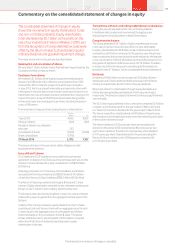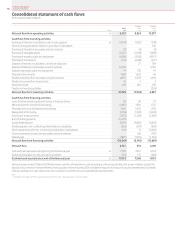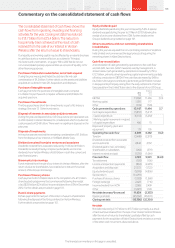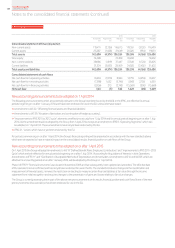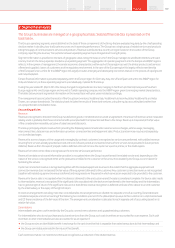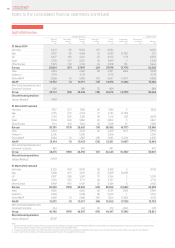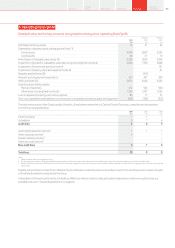Vodafone 2014 Annual Report Download - page 107
Download and view the complete annual report
Please find page 107 of the 2014 Vodafone annual report below. You can navigate through the pages in the report by either clicking on the pages listed below, or by using the keyword search tool below to find specific information within the annual report.
Business combinations and goodwill
When a business combination occurs, the fair values of the identiable assets and liabilities assumed, including intangible assets, are recognised.
The determination of the fair values of acquired assets and liabilities is based, to a considerable extent, on management’s judgement. If the purchase
consideration exceeds the fair value of the net assets acquired then the difference is recognised as goodwill. If the purchase price consideration
is lower than the fair value of the assets acquired then a gain is recognised in the income statement.
Allocation of the purchase price between nite lived assets (discussed below) and indenite lived assets such as goodwill affects the results of the
Group as nite lived intangible assets are amortised, whereas indenite lived intangible assets, including goodwill, are not amortised.
On transition to IFRS the Group elected not to apply IFRS 3, “Business combinations”, retrospectively as the difculty in applying these requirements
to business combinations completed by the Group from incorporation through to 1 April 2004 exceeded any potential benets. Goodwill arising
before the date of transition to IFRS amounted to £78,753 million.
If the Group had elected to apply the accounting for business combinations retrospectively it may have led to an increase or decrease in goodwill,
licences, customer bases, brands and related deferred tax liabilities recognised on acquisition.
Joint arrangements
The Group participates in a number of joint arrangements where control of the arrangement is shared with one or more other parties. A joint
arrangement is classied as a joint operation or as a joint venture, depending on management’s assessment of the legal form and substance
of the arrangement.
The classication can have a material impact on the consolidated nancial statements. The Group’s share of assets, liabilities, revenue, expenses and
cash ows of joint operations are included in the consolidated nancial statements on a line-by-line basis, whereas the Group’s investment and share
of results of joint ventures are shown within single line items in the consolidated statement of nancial position and consolidated income statement
respectively. See note 12 “Investments in associates and joint ventures” to the consolidated nancial statements.
Finite lived intangible assets
Other intangible assets include amounts spent by the Group acquiring licences and spectrum, customer bases and brands and the costs
of purchasing and developing computer software.
Where intangible assets are acquired through business combinations and no active market for the assets exists, the fair value of these assets
is determined by discounting estimated future net cash ows generated by the asset. Estimates relating to the future cash ows and discount rates
used may have a material effect on the reported amounts of nite lived intangible assets.
Estimation of useful life
The useful life over which intangible assets are amortised depends on management’s estimate of the period over which economic benet will
be derived from the asset. Reducing the useful life will increase the amortisation charge in the consolidated income statement. Useful lives are
periodically reviewed to ensure that they remain appropriate. The basis for determining the useful life for the most signicant categories of intangible
assets is discussed below.
Licences and spectrum fees
The estimated useful life is generally the term of the licence unless there is a presumption of renewal at negligible cost; this is adjusted if necessary,
for example taking into account the impact of any expected changes in technology.
Customer bases
The estimated useful life principally reects management’s view of the average economic life of the customer base and is assessed by reference
to customer churn rates. An increase in churn rates may lead to a reduction in the estimated useful life and an increase in the amortisation charge.
Capitalised software
For computer software, the useful life is based on management’s view, considering historical experience with similar products as well as anticipation
of future events which may impact their life such as changes in technology. The useful life will not exceed the duration of a licence.
Property, plant and equipment
Property, plant and equipment represents 18.8% (2013: 12.7%) of the Group’s total assets; estimates and assumptions made may have a material
impact on their carrying value and related depreciation charge. See note 11 “Property, plant and equipment” for further details.
Estimation of useful life
The depreciation charge for an asset is derived using estimates of its expected useful life and expected residual value, which are reviewed annually.
Increasing an asset’s expected life or residual value would result in a reduced depreciation charge in the consolidated income statement.
Management determines the useful lives and residual values for assets when they are acquired, based on experience with similar assets and taking
into account other relevant factors such as any expected changes in technology. The useful life of network infrastructure is assumed not to exceed
the duration of related operating licences unless there is a reasonable expectation of renewal or an alternative future use for the asset.
Post employment benets
Management judgement is exercised when determining the Group’s liabilities and expenses arising for dened benet pension schemes.
Management is required to make assumptions regarding future rates of ination, salary increases, discount rates and longevity of members, each
of which may have a material impact on the dened benet obligations that are recorded. Sensitivity analysis is provided for these assumptions
in note 26 “Post employment benets” to the consolidated nancial statements.
Annual Report 2014 105Overview
Strategy
review Performance Governance Financials Additional
information








